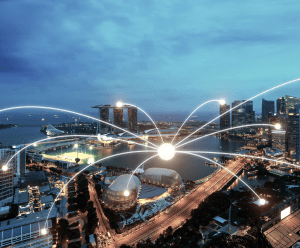
How Asia Pacific is strengthening information flow to boost digital trade growth

Digital information flows crisscross the modern world, connecting nations, businesses, and communities in powerful ways. As DHL’s Global Connectedness Index highlights, these flows are essential for supporting global trade growth. The index measures globalization based on international flows of trade, capital, people, and information. It suggests that a new era of “digital globalization” is underway, fueled by the increasing digitization of international trade.
Demand for digital trade – e-commerce plus services delivered internationally through the internet – is soaring. In 2022, digital trade was worth an estimated US$3.82 trillion worldwide.
“Digital information flows surging within and between countries are the vital “conveyor belt” of this transformation, helping to open new avenues for trade, innovation, and productivity expansion,” said Ken Lee, CEO, DHL Express Asia Pacific.
But how well does Asia Pacific enable these flows that feed the global digital economy? And what do businesses need to know about this fast-evolving era of information globalization?
Building a connected region
High-quality, resilient connectivity infrastructure lies at the heart of digital trade. The infrastructure supporting information flows – from the internet to undersea cables, satellite systems, and other telecommunications networks – is critical to facilitate document sharing, online transactions, payment processing, and the movement of goods and services across the globe.
Asia-Pacific countries are already global frontrunners in supporting ultrafast mobile broadband speeds. For example, in 2019, South Korea became the first nation to deploy a commercial 5G network, followed by Australia, China, New Zealand, and the Philippines later that year. Research also shows that in 2023, South Korea, China, and Japan were the world leaders in 5G adoption, measured as the percentage of 5G connections compared to total connections. China, for instance, has over 700 million 5G household connections, equivalent to 41 percent of connections.
Data centers are another core part of the infrastructure puzzle, providing businesses with a secure way to store and disseminate their growing organizational data, applications and centralized IT operations. In Asia Pacific, research indicates that the data center sector has seen a 300 percent growth in capacity over the past five years as e-commerce continues to grow and businesses ramp up their digital transformation journeys. By 2028, the market is expected to reach over US$53 billion as it expands at a compound annual growth rate (CAGR) of 12 percent from 2023 to 2028.
Among other major infrastructure projects, governments across the region are collaborating to build a resilient subsea cable network that can enable the free flow of data. For example, a transpacific cable system was launched every year between 2016 and 2020, with at least eight additional systems planned until 2024. Notable projects include a 9,400-kilometer cable connecting Hong Kong, China’s Guangdong province, Japan, the Philippines, Singapore, Thailand, and Vietnam.
However, despite the region’s great progress in deepening regional connectivity through advanced technologies, it remains conspicuously digitally divided. More than a quarter of the population remains disconnected from the internet. Bridging this divide will require a coordinated effort from stakeholders, including governments, private sectors, non-governmental organizations, and communities.
Accelerating digital transformation
Asia Pacific’s infrastructure modernization is vital in a region that’s seeing burgeoning demand for digital services – from cloud computing and video streaming to e-commerce. Forecasts suggest that by 2030, the internet economy in Southeast Asia alone will reach US$1 trillion, driven by a fast-growing base of tech-savvy consumers hungry to embrace new digital experiences.
Adequate bandwidth is also essential for the adoption and effective functioning of AI applications, which process huge data volumes to identify complex patterns and develop actionable insights. Studies show that Asia Pacific is the world’s fastest-growing AI market, with a CAGR of 20.3 percent compared to a global CAGR of 19 percent.
Countries including China, Japan, South Korea, India, Taiwan, and Singapore have all announced multi-million-dollar national strategies to help drive AI (including generative AI) readiness and regulate its deployment.
This groundwork is helping to set up the region as a conducive environment in which innovative technology-enabled organizations can emerge and thrive. For example, it’s enabling leading manufacturers to use digitalization to improve logistics and production planning, allowing for greater visibility and control of their supply chains.
Supporting cross-border collaboration and innovation
As DHL’s Global Connectedness Index highlights, the ability to move data and information seamlessly around the globe supports the open exchange of ideas and perspectives. This is essential to build business partnerships across borders, spur research and development, and support innovative new products and services.
Asia Pacific’s business community is firmly committed to deepening knowledge flow and collaboration across borders. According to a recent report from the Asia-Pacific Economic Cooperation’s Business Advisory Council, businesses can “leverage synergies from engaging collectively, embracing the challenges and enabling our communities, in order to realize the full potential of our region.”
In annual rankings of the world’s economies on innovation capacity and output, Asia-Pacific nations also consistently score highly. For example, the World Intellectual Property Organization’s Global Innovation Index for 2023 ranks Singapore fifth. It also reveals that the world's top five science and technology innovation hubs are all Asia-based – in Tokyo-Yokohama, Shenzhen-Hong Kong-Guangzhou, Seoul, Beijing, and Shanghai –and building up substantial intellectual property.
Understanding regulatory frameworks
The globalized nature of modern information flows also raises the vital issue of protecting sensitive data and ensuring users’ privacy when data flows across borders.
Few agreed international rules exist in this area. A patchwork of frameworks, principles, and norms has arisen as governments try to find ways to safely maintain some level of international openness while meeting legitimate data protection and national security concerns.
Many countries have international cooperation mechanisms in their data governance policies that allow data to be transferred overseas. Some have also endorsed common principles for privacy and security that deliver multiple benefits –for example, allowing law enforcement agencies to assist each other if a cybercrime occurs. It’s also common for nations to participate alongside industry actors in technical organizations that set global standards for interoperability – that is, different systems’ ability to communicate and exchange data.
But as the DHL Global Connectedness Index points out, a proliferation of domestic regulations affecting international data flows has also emerged, which could dampen global trade growth prospects. These include stipulations that data generated within a country’s borders must also be physically stored or processed there – a concept known as “data localization.” Indonesia, for instance, has enacted data localization in specific areas including the financial sector.
The index highlights economic research that consistently indicates the adverse effects of such data flow restrictions. It points to one study that suggests a one-point increase in data restrictiveness for any given country results in a 7 percent decrease in trade output, a reduction in productivity of almost 3 percent, and a 1.5 percent long-term increase in prices for downstream industries. It also cites a forecast predicting that data restrictions coming into effect in five Asian countries – Bangladesh, Hong Kong, Indonesia, Pakistan, and Vietnam – could reduce their overall trade volumes by 3.7 percent to 9 percent after five years.
Towards a more resilient and connected future
"Despite the potential barriers to cross-border data exchange, a bright picture emerges of the resilience of information flows in Asia Pacific today,” noted Lee.
As nations here strategically embrace digital infrastructure innovation, businesses can better deploy the cutting-edge technologies they need to participate in the global digital economy. The flow of data and information between countries is also creating powerful innovation hubs. These can encourage the sharing of fresh ideas and foster new waves of technology breakthroughs.
In short, as the globalization of information flows continues, it is helping to lay the groundwork for a more connected, intelligent, and dynamic Asia Pacific—one where digital trade can flourish.
MORE FROM THIS COLLECTION
















 English
English